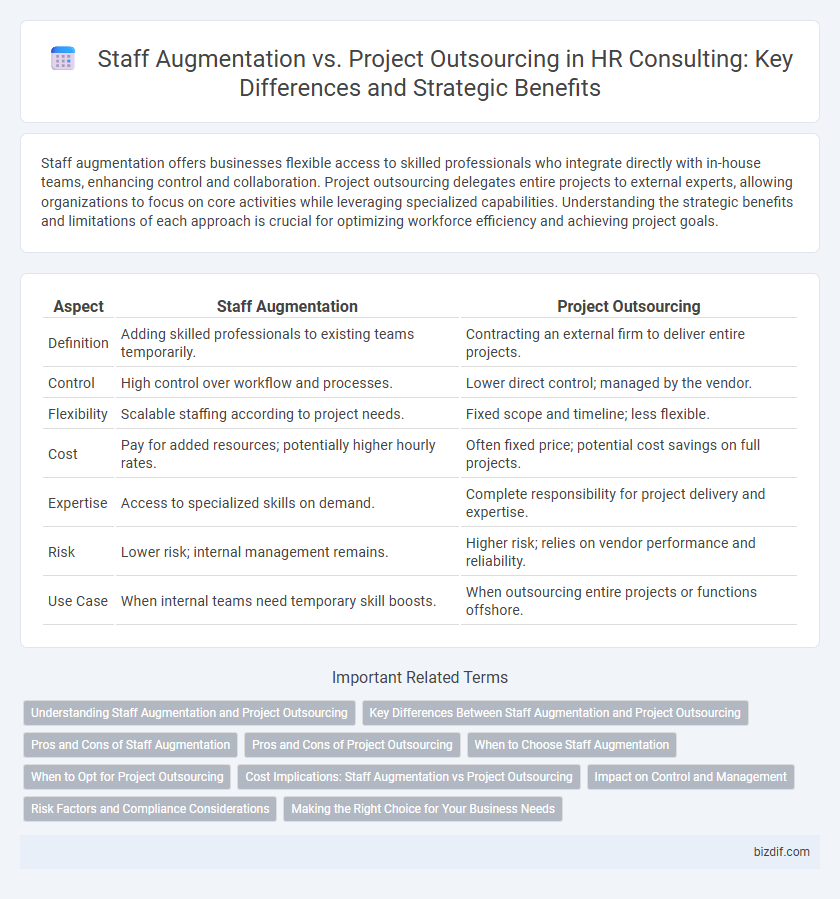Staff augmentation offers businesses flexible access to skilled professionals who integrate directly with in-house teams, enhancing control and collaboration. Project outsourcing delegates entire projects to external experts, allowing organizations to focus on core activities while leveraging specialized capabilities. Understanding the strategic benefits and limitations of each approach is crucial for optimizing workforce efficiency and achieving project goals.
Table of Comparison
| Aspect | Staff Augmentation | Project Outsourcing |
|---|---|---|
| Definition | Adding skilled professionals to existing teams temporarily. | Contracting an external firm to deliver entire projects. |
| Control | High control over workflow and processes. | Lower direct control; managed by the vendor. |
| Flexibility | Scalable staffing according to project needs. | Fixed scope and timeline; less flexible. |
| Cost | Pay for added resources; potentially higher hourly rates. | Often fixed price; potential cost savings on full projects. |
| Expertise | Access to specialized skills on demand. | Complete responsibility for project delivery and expertise. |
| Risk | Lower risk; internal management remains. | Higher risk; relies on vendor performance and reliability. |
| Use Case | When internal teams need temporary skill boosts. | When outsourcing entire projects or functions offshore. |
Understanding Staff Augmentation and Project Outsourcing
Staff augmentation involves integrating external professionals into a company's existing workforce to fill skill gaps and scale teams temporarily, enhancing flexibility and control. Project outsourcing delegates entire projects to third-party vendors who manage all aspects, from planning to delivery, enabling businesses to focus on core activities while leveraging specialized expertise. Understanding these differences helps organizations make strategic decisions based on resource control, project complexity, and cost efficiency.
Key Differences Between Staff Augmentation and Project Outsourcing
Staff augmentation involves hiring external professionals to temporarily supplement an internal team, allowing companies to retain control over project management and execution. Project outsourcing delegates entire project responsibilities to an external vendor, which manages resources, timelines, and deliverables independently. Key distinctions include control level, resource management, and accountability, with staff augmentation providing flexibility and direct oversight, while project outsourcing offers turnkey solutions with reduced management burden.
Pros and Cons of Staff Augmentation
Staff augmentation offers flexible scalability by allowing companies to quickly add skilled professionals to their existing teams, enhancing control over project processes and maintaining in-house knowledge continuity. However, it may involve higher management overhead, as internal resources must supervise and integrate augmented staff, potentially leading to increased operational complexity. Unlike project outsourcing, which transfers full responsibility and reduces managerial burden, staff augmentation requires sustained internal oversight and can result in variable costs depending on project duration and resource availability.
Pros and Cons of Project Outsourcing
Project outsourcing enables businesses to access specialized expertise and advanced technologies without long-term commitments, reducing in-house workload and operational costs. However, it may lead to less control over project timelines and quality, potential communication barriers, and challenges in aligning outsourced teams with company culture. Firms must weigh the benefits of scalability and cost-efficiency against risks like dependency on external vendors and potential security concerns.
When to Choose Staff Augmentation
Staff augmentation is ideal when companies require flexible scaling of their in-house teams to address specific skill gaps or meet project deadlines without long-term commitments. This approach allows direct control over augmented staff, ensuring seamless collaboration and alignment with internal processes. Organizations facing fluctuating workloads or needing specialized expertise for short-term projects benefit most from staff augmentation over project outsourcing.
When to Opt for Project Outsourcing
Project outsourcing is ideal when companies require specialized expertise unavailable in-house or seek to reduce operational costs by delegating entire projects to external vendors. It enables access to scalable resources and accelerates project timelines while maintaining a clear focus on core business functions. Opt for project outsourcing when long-term commitments and comprehensive deliverables outweigh the need for direct employee integration.
Cost Implications: Staff Augmentation vs Project Outsourcing
Staff augmentation typically involves direct hourly or salaried payments to supplemented employees, leading to higher short-term costs but greater control over labor quality and scheduling. Project outsourcing often reduces overhead by transferring the entire project scope to an external vendor, who manages resources and timelines, resulting in more predictable, fixed costs that can lower overall expenditure. Evaluating total cost of ownership, including management overhead and potential scalability, is critical for informed decision-making between staff augmentation and project outsourcing in HR consulting.
Impact on Control and Management
Staff augmentation allows organizations to retain full control over project management and decision-making by integrating external experts within their existing teams. Project outsourcing transfers management responsibilities to the third-party provider, reducing direct oversight but potentially increasing efficiency through specialized expertise. Choosing between the two depends on the desired level of control, with staff augmentation offering hands-on management and project outsourcing enabling a more hands-off approach.
Risk Factors and Compliance Considerations
Staff augmentation involves integrating external talent into internal teams, which requires maintaining strict compliance with labor laws and data security standards to mitigate risks related to intellectual property and confidentiality breaches. Project outsourcing transfers full responsibility to a third-party vendor, raising concerns about vendor reliability, quality control, and adherence to contractual obligations and industry regulations such as GDPR or OSHA. Both models demand thorough due diligence, clear compliance frameworks, and risk management strategies to prevent legal liabilities and operational disruptions.
Making the Right Choice for Your Business Needs
Choosing between staff augmentation and project outsourcing depends on your business goals, required expertise, and control preferences. Staff augmentation offers flexible scaling of in-house teams with specialized professionals, enhancing project control and alignment with company culture. Project outsourcing transfers entire project responsibilities to external vendors, ideal for cost-efficiency and accessing comprehensive skill sets without expanding internal staff.
Staff Augmentation vs Project Outsourcing Infographic

 bizdif.com
bizdif.com